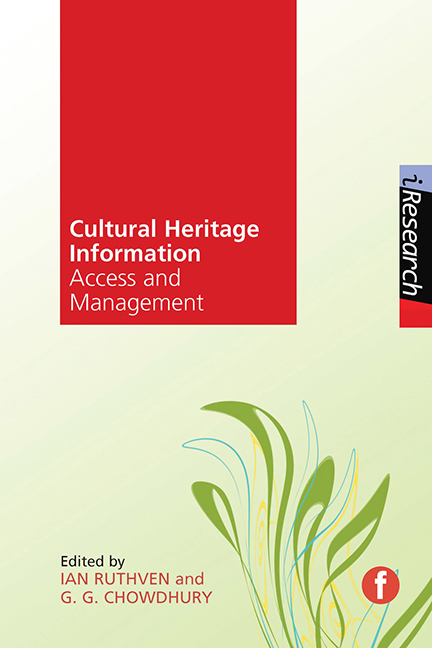Book contents
- Frontmatter
- Contents
- List of figures and tables
- Contributors
- Preface
- 1 Managing digital cultural heritage information
- 2 Digital humanities and digital cultural heritage (alt-history and future directions)
- 3 Management of cultural heritage information: policies and practices
- 4 Cultural heritage information: artefacts and digitization technologies
- 5 Metadata in cultural contexts – from manga to digital archives in a linked open data environment
- 6 Managing cultural heritage: information systems architecture
- 7 Cultural heritage information: users and usability
- 8 A framework for classifying and comparing interactions in culturalheritage information systems
- 9 Semantic access and exploration in cultural heritage digital libraries
- 10 Supporting exploration and use of digital cultural heritage materials: the PATHS perspective
- 11 Cultural heritage information services: sustainability issues
- Index
1 - Managing digital cultural heritage information
Published online by Cambridge University Press: 10 September 2022
- Frontmatter
- Contents
- List of figures and tables
- Contributors
- Preface
- 1 Managing digital cultural heritage information
- 2 Digital humanities and digital cultural heritage (alt-history and future directions)
- 3 Management of cultural heritage information: policies and practices
- 4 Cultural heritage information: artefacts and digitization technologies
- 5 Metadata in cultural contexts – from manga to digital archives in a linked open data environment
- 6 Managing cultural heritage: information systems architecture
- 7 Cultural heritage information: users and usability
- 8 A framework for classifying and comparing interactions in culturalheritage information systems
- 9 Semantic access and exploration in cultural heritage digital libraries
- 10 Supporting exploration and use of digital cultural heritage materials: the PATHS perspective
- 11 Cultural heritage information services: sustainability issues
- Index
Summary
Introduction
Heritage is our legacy from the past, what we live with today, and what we pass on to future generations (UNESCO, 2008). Cultural heritage is commonly divided into two categories (Cane and Conagham, 2009):
1 Tangible cultural heritage that are material, and can be (a) movable objects, such as paintings, antiquities or artefacts and (b) immovable objects such as buildings, monuments or archaeological sites; and
2 Intangible cultural heritage that cannot be touched but which can be felt through other sensory organs – for example, can be seen, as in the case of a dance or performance of a play or ritual, or can be heard, as in the case of music, stories, etc.
A new form of cultural heritage is born when the tangible or intangible heritage objects are digitized; and this is commonly referred to as digital cultural heritage or cultural heritage information resources (Lor and Britz, 2012). Cultural heritage information resources may include a wide variety of content, objects and artefacts. According to the European Commission, Europe's cultural memory includes print (books, journals and newspapers), photographs, museum objects, archival documents, sound and audio visual materials, monuments and archaeological sites (European Commission, 2011).
Cultural heritage in the parlance of the World Intellectual Property Organization may be either intangible, tangible or, most usually, combinations of the two – an example of such a ‘mixed expression of folklore’ would be a woven rug (a tangible expression) that expresses elements of a traditional story (an intangible expression) (WIPO, n.d.).
Cultural heritage content may come in many different forms, such as:
• verbal expressions, such as folk tales, folk poetry and riddles, signs, words, symbols and indications
• musical expressions, such as folk songs and instrumental music
• expressions by actions, such as folk dances, plays and artistic forms or rituals, whether or not reduced to a material form
• tangible expressions, such as:
— productions of folk art, in particular, drawings, paintings, carvings, sculptures, pottery, terracotta, mosaic, woodwork, metalware, jewellery, basket weaving, needlework, textiles, carpets, costumes
— crafts
— musical instruments
— architectural forms.
A number of publications covering different aspects of digital cultural heritage have appeared over the past decade or so (Cameron and Kenderdine, 2007; Cane and Conagham, 2009; Feather, 2006; Lor and Britz, 2012), and they cover a wide range of themes such as:
- Type
- Chapter
- Information
- Cultural Heritage InformationAccess and Management, pp. 1 - 12Publisher: FacetPrint publication year: 2015
- 1
- Cited by



